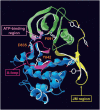FLT3 INHIBITORS: RECENT ADVANCES AND PROBLEMS FOR CLINICAL APPLICATION
- PMID: 25797966
- PMCID: PMC4361503
FLT3 INHIBITORS: RECENT ADVANCES AND PROBLEMS FOR CLINICAL APPLICATION
Abstract
FLT3, a type III receptor tyrosine kinase, expresses on most acute leukemia cells as well as normal hematopoietic stem/progenitor cells. Mutation in the FLT3 gene is the most frequent genetic alteration in acute myeloid leukemia (AML) and is well known as an important driver mutation for the development of myeloid malignancies. FLT3 mutation is a strong poor prognostic factor for the long-term survival in AML patients, while neither high-dose chemotherapy nor allogeneic hematopoietic stem cell transplantation can overcome a poor prognosis. Development of an FLT3 inhibitor is, therefore, much awaited. To date, several potent FLT3 inhibitors have been developed and some of them were evaluated for efficacy in clinical trials, although no FLT3 inhibitor has been yet approved. Moreover, several problems for clinical use, such as adverse effects, blood concentration and resistance have been apparent. Recently developed AC220 is a highly selective and sensitive FLT3 inhibitor. In Phase I and II trials, AC220 so far showed the best efficacy of AML cells harboring FLT3 mutation among clinically evaluated FLT3 inhibitors, while severe bone marrow suppression and QTc prolongation should be resolved for the clinical use. In this review, I summarize the characteristics of FLT3 inhibitors in clinical development and discuss important issues to be resolved for clinical use.
Keywords: FLT3; inhibitors; leukemia; molecular target; resistance.
Figures



Comment in
-
A never-ending FLT3 story.Nagoya J Med Sci. 2023 Feb;85(1):27-29. doi: 10.18999/nagjms.85.1.27. Nagoya J Med Sci. 2023. PMID: 36923638 Free PMC article. No abstract available.
Similar articles
-
FLT3 mutations in acute myeloid leukemia: Therapeutic paradigm beyond inhibitor development.Cancer Sci. 2020 Feb;111(2):312-322. doi: 10.1111/cas.14274. Epub 2019 Dec 30. Cancer Sci. 2020. PMID: 31821677 Free PMC article. Review.
-
Receptor tyrosine kinase Axl is required for resistance of leukemic cells to FLT3-targeted therapy in acute myeloid leukemia.Leukemia. 2015 Dec;29(12):2382-9. doi: 10.1038/leu.2015.147. Epub 2015 Jun 19. Leukemia. 2015. PMID: 26172401 Free PMC article.
-
[FLT3 inhibitors in the treatment of FLT3-mutated acute myeloid leukemia].Rinsho Ketsueki. 2021;62(8):954-966. doi: 10.11406/rinketsu.62.954. Rinsho Ketsueki. 2021. PMID: 34497236 Japanese.
-
Leukemogenic potency of the novel FLT3-N676K mutant.Ann Hematol. 2016 Apr;95(5):783-91. doi: 10.1007/s00277-016-2616-z. Epub 2016 Feb 19. Ann Hematol. 2016. PMID: 26891877
-
Quizartinib (AC220): a promising option for acute myeloid leukemia.Drug Des Devel Ther. 2019 Apr 8;13:1117-1125. doi: 10.2147/DDDT.S198950. eCollection 2019. Drug Des Devel Ther. 2019. PMID: 31114157 Free PMC article. Review.
Cited by
-
Identification of the key genes and microRNAs in adult acute myeloid leukemia with FLT3 mutation by bioinformatics analysis.Int J Med Sci. 2020 May 18;17(9):1269-1280. doi: 10.7150/ijms.46441. eCollection 2020. Int J Med Sci. 2020. PMID: 32547322 Free PMC article.
-
Treatment of Acute Myeloid Leukemia with the FLT3 Gene Mutation.Curr Oncol Rep. 2017 Mar;19(3):21. doi: 10.1007/s11912-017-0573-x. Curr Oncol Rep. 2017. PMID: 28283965 Review.
-
A never-ending FLT3 story.Nagoya J Med Sci. 2023 Feb;85(1):27-29. doi: 10.18999/nagjms.85.1.27. Nagoya J Med Sci. 2023. PMID: 36923638 Free PMC article. No abstract available.
-
Comprehensive Molecular Profiling of NPM1-Mutated Acute Myeloid Leukemia Using RNAseq Approach.Int J Mol Sci. 2024 Mar 24;25(7):3631. doi: 10.3390/ijms25073631. Int J Mol Sci. 2024. PMID: 38612443 Free PMC article.
-
Co-expression of wild-type FLT3 attenuates the inhibitory effect of FLT3 inhibitor on FLT3 mutated leukemia cells.Oncotarget. 2016 Jul 26;7(30):47018-47032. doi: 10.18632/oncotarget.10147. Oncotarget. 2016. PMID: 27331411 Free PMC article.
References
-
- Estey E, Dohner H. Acute myeloid leukaemia. Lancet, 2006; 368: 1894–1907. - PubMed
-
- Döhner H, Estey EH, Amadori S, Appelbaum FR, Büchner T, Burnett AK, Dombret H, Fenaux P, Grimwade D, Larson RA, Lo-Coco F, Naoe T, Niederwieser D, Ossenkoppele GJ, Sanz MA, Sierra J, Tallman MS, Löwenberg B, Bloomfield CD; European LeukemiaNet. Diagnosis and management of acute myeloid leukemia in adults: recommendations from an international expert panel, on behalf of the European LeukemiaNet. Blood, 2010; 115: 453–474. - PubMed
-
- Kihara R, Nagata Y, Kiyoi H, Kato T, Yamamoto E, Suzuki K, Chen F, Asou N, Ohtake S, Miyawaki S, Miyazaki Y, Sakura T, Ozawa Y, Usui N, Kanamori H, Kiguchi T, Imai K, Uike N, Kimura F, Kitamura K, Nakaseko C, Onizuka M, Takeshita A, Ishida F, Suzushima H, Kato Y, Miwa H, Shiraishi Y, Chiba K, Tanaka H, Miyano S, Ogawa S, Naoe T. Comprehensive analysis of genetic alterations and their prognostic impacts in adult acute myeloid leukemia patients. Leukemia, 2014 Aug; 28(8): 1586–1595 - PubMed
-
- Rosnet O, Marchetto S, deLapeyriere O, Birnbaum D. Murine Flt3, a gene encoding a novel tyrosine kinase receptor of the PDGFR/CSF1R family. Oncogene, 1991; 6: 1641–1650. - PubMed
Publication types
LinkOut - more resources
Full Text Sources
Other Literature Sources
Miscellaneous
